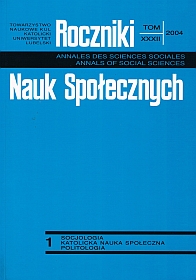Pomniki i obiekty architektoniczne jako symbole kształtujące tożsamość miejsca (przypadek Gdańska)
Abstrakt
Gdańsk is a very interesting object of research. It is here that the process of making the Polish society subject-oriented started in 1980; it is here that originated the “Autumn of the Peoples in 1989”. This city has a many-aged tradition in which one may find Polish, Kashoubian, German, Hanzeatic, and Netherlandic manifestations of the creative spirit. The paper sought to show the semeiotic landscape of Gdańsk, therefore those elements, which consitute its differentia specifica. The symbols of the city are among the essential grounds upon which to form the character and identity of the city. In the light of the research, Gdańsk appears to be a city that is distinctly different from other Polish citites, and it is mainly its monuments and numerous historic places that join the impact of many cultures. The enormous symbolical force is concentrated in architecture and monuments and it enhances the sense of roots. It is owing to them that one can distinctly feel that the place is unique, feel its specific character and prestige.
Bibliografia
Bartoszek A., Gruszczyński L. A., Szczepański M. S. (1997): Miasto i mieszkanie w społecznej świadomości, Katowice.
Bauman Z. (1996): Etyka ponowoczesna, Warszawa.
Bauman Z. (1997): O turystach i włóczęgach, czyli bohaterach i ofiarach ponowoczesności, [w:] Pamięć, miejsce, obecność, red. J. P. Hudzik, J. Mizińska, Lublin.
Bauman Z. (1998): Identity – Then, Now, what For?, „Polish Sociological Review”, No.3.
Böhm A. (1981): O budowie i synergii wnętrz urbanistycznych, (Monografia nr 16), Kraków.
Böhm A. (1986): Percepcja formy urbanistycznej w pracy Amosa Rapoporta, „Teka Komisji Urbanistyki i Architektury”, t. XX.
Czaplicka J. (1995): History, Aesthetics, and Contemporary Commemorative Practice in Berlin, „Journal of European Psychoanalisis”, No. 1.
Dyczewski L. (1995): Kultura polska w procesie przemian, Lublin.
Eco U. (1972): Pejzaż semiotyczny, Warszawa.
Eco U. (1996): Funkcja i znak; semiologia architektury, [w:] Nieobecna struktura, Warszawa.
Harvey D. (1985a): The Urbanization of Capital. Studies in the History and Theory of Capitalist Urbanization, Oxford: Blackwell.
Harvey D. (1985b): Consciousness and the Urban Experience. Studies in the History and Theory of Capitalist Urbanization, Oxford: Blackwell.
Jałowiecki B. (1988): Społeczne wytwarzanie przestrzeni, Warszawa.
Kłoskowska A. (1983): Socjologia kultury, Warszawa.
Ledrut R. (1970): L'image de la ville, „Espaces et Sociétés”, nr 1.
Libura H. (1990): Percepcja przestrzeni miejskiej, Warszawa.
Lofland L. H. (1973): A World of Strangers. Order and Action in Urban Public Space, Illinois.
Melchior M. (1990): Społeczna tożsamość jednostki, Warszawa.
Michałowski L. (2000): Gdańsk w świadomości jego młodych mieszkańców, Praca doktorska, mps, Wyższa Szkoła Nauk Społecznych, Warszawa.
Molotch H., Freudenburg W., Paulsen K. E. (2000): History Repeats Itself, But How? City Character, Urban Tradition, And The Accomplishment Of Place, „American Sociological Review”, No. 6.
Niżnik J. (1985): Symbol a adaptacja kulturowa, Warszawa.
Pred A. (1990): Making Histories and Constructing Human Geographies. The Local Transformation of Practice, Power Relations and Consciousness, Boulder.
Rapoport A. (1977): Human Aspects of Urban Form. Towards a Man – Environment Approach to Urban Form and Design, Pergamon Press.
Relph E. C. (1976): Place and Placelessness, London.
Rusecki M. (1981): Cud jako znak i symbol, „Roczniki Teologiczno-Kanoniczne”, z.2.
Sagan I. (2000): Miasto – scena konfliktów i współpracy. Rozwój miast w świetle koncepcji reżimu miejskiego, Gdańsk.
Susuł L. (1980): Pomnik i ludzie, „Tygodnik Powszechny”, nr 50.
Synak B. (1998): Kaszubska tożsamość. Ciągłość i zmiana, Gdańsk.
Szczepański M. S. (1989): Społeczne wytwarzanie przestrzeni miejskiej i generowanie znaczeń, [w:] Przestrzeń znacząca, (Studia socjologiczne, red. J. Wódz), Katowice.
Szczepański M. S. (1991): Wartości ekologiczne przestrzeni i miejsc. Wyniki badań empirycznych, [w:] Przestrzeń wielkiego miasta w perspektywie badań nad planowaniem i żywiołowością, red. K. Wódz, Katowice.
Tarnacki J. (1998): Pomniki ogarnięte. Rozmawiała K. Skrzydłowska, „Gazeta Wyborcza”, nr 25 − dodatek „Gazeta Morska”.
Tazbir J. (1997): Walka na pomniki i o pomniki, „Kultura i Społeczeństwo”, nr 1.
Tuan Y-F. (1987): Przestrzeń i miejsce, Warszawa.
Tusk D. (1995): Był sobie Gdańsk, „Przegląd Polityczny”, nr 25.
Wallis A. (1977): Miasto i przestrzeń, Warszawa.
Wallis A. (1985): Pamięć i pomnik, [w:] Społeczeństwo i socjologia. Wrocław.
Wallis M. (1961): Świat sztuk, świat znaków, „Estetyka”, nr 2.
Copyright (c) 2004 Roczniki Nauk Społecznych

Utwór dostępny jest na licencji Creative Commons Uznanie autorstwa – Użycie niekomercyjne – Bez utworów zależnych 4.0 Międzynarodowe.


